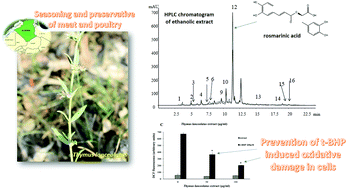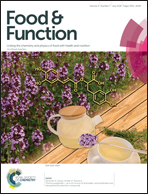Thymus lanceolatus ethanolic extract protects human cells from t-BHP induced oxidative damage
Abstract
This study aimed to investigate the ethanolic extract of T. lanceolatus, a species native to north-western Algeria, traditionally used as herbal tea, seasoning and a preservative for meat and poultry. HPLC analysis showed the presence of fourteen bioactive compounds, among which rosmarinic acid is by far the most abundant one (15440.9 mg kg−1). Its biological activity on proliferation, viability and ROS protection was investigated towards K562, CaCo-2 and SH-SY5Y human cancer cell lines. Cell proliferation was inhibited in K562 and SH-SY5Y cells in the first 48 h at 500 μg mL−1 but slowly resumed after 72 h. A weak cytotoxic effect can be observed at 24, 48 and 72 hours: 12.8%, 14.9% and 24.2% reduction in K562 viability, and 11%, 15% and 12.7% in SH-SY5Y. No cytotoxicity was observed in CaCo-2 cells under the same experimental conditions. Even at the lowest concentrations (50 μg mL−1), the extract was efficiently able to protect human cells against t-BHP-induced oxidative damage. For instance, the highest concentration of the extract (100 μg mL−1) decreases ROS generation by about 30% in SH-SY5Y and 70% in CaCo-2 and K562 cells. The study confirms the very low cytotoxicity of the T. lanceolatus ethanolic extract and highlights its nutraceutical properties as an antioxidative and preservative agent and its possible use as an ingredient in functional foods.



 Please wait while we load your content...
Please wait while we load your content...